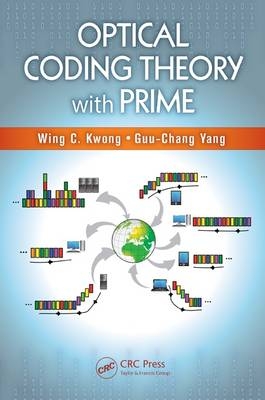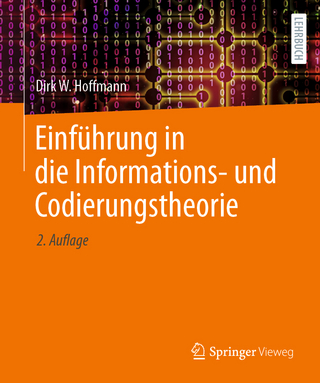
Optical Coding Theory with Prime
Crc Press Inc (Verlag)
978-1-4665-6780-1 (ISBN)
Learn How to Construct and Analyze Optical Codes
The authors use a theorem-proof approach, breaking down theories into digestible form so that readers can understand the main message without searching through tedious proofs. The book begins with the mathematical tools needed to understand and apply optical coding theory, from Galois fields and matrices to Gaussian and combinatorial analytical tools. Using a wealth of examples, the authors show how optical codes are constructed and analyzed, and detail their performance in a variety of applications. The book examines families of 1-D and 2-D asynchronous and synchronous, multilength, and 3-D prime codes, and some non-prime codes.
Get a Working Knowledge of Optical Coding Theory to Help You Design Optical Systems and Networks
Prerequisites include a basic knowledge of linear algebra and coding theory, as well as a foundation in probability and communications theory. This book draws on the authors’ extensive research to offer an authoritative reference on the emerging field of optical coding theory. In addition, it supplies a working knowledge of the theory and optical codes to help readers in the design of coding-based optical systems and networks.
For more on the technological aspects of optical CDMA, see Optical Code Division Multiple Access: Fundamentals and Applications (CRC Press 2005).
Wing C. Kwong is currently a professor in the Department of Engineering at Hofstra University, New York. He has published numerous professional articles, chaired technical sessions and served technical program committees in international conferences, and has given seminars and tutorials around the world. His research interests include optical and wireless communication systems and multiple-access networks, optical interconnection networks, and ultrafast all-optical signal processing techniques. Dr. Kwong is a senior member of the IEEE and is currently an associate editor of the IEEE Transactions on Communications. He received a NEC Graduate Fellowship awarded by the NEC Research Institute, Princeton, New Jersey, in 1991, and the Young Engineer Award from the IEEE (Long Island chapter) in 1998. Guu-Chang Yang is currently a professor in the Department of Electrical Engineering and the Graduate Institute of Communication Engineering at National Chung Hsing University, Taiwan. His research interests include wireless and optical communication systems, modulation and signal processing techniques, and applications of CDMA. Dr. Yang is the area coordinator of the National Science Council’s Telecommunications Program (2012-2014), co-coordinator of the National Science Council’s National Networked Communication Program (2010-2013), and chairman of the IEEE Communications Society Taipei Chapter (2013-2014). He became an IEEE Fellow in 2012 for contributions to optical CDMA. He has received several awards, including the Distinguished Research Award from the National Science Council in 2004, and the Outstanding Young Electrical Engineer Award in 2003 and the Distinguished Electrical Engineering Professor Award in 2012, both from the Chinese Institute of Electrical Engineering.
Fundamental Materials and Tools: Galois Fields. Vector Space. Matrix Theory. Hamming Distance and Weight. Correlation Functions. Cardinality Upper Bound. Markov Chain. Algebraic Tools for Performance Analysis. Summary. Optical Coding Schemes: 1-D Temporal Amplitude Coding. 1-D Temporal Phase Coding. 1-D Spectral Phase Coding. 1-D Spectral Amplitude Coding. 2-D Spatial-Temporal Amplitude Coding. 2-D Spectral-Temporal Amplitude Coding. Three-Dimensional Coding. Multirate and Multiple-QoS Coding. Multicode Keying and Shifted-Code Keying. Enabling Hardware Technologies. Potential Applications. Summary. 1-D Asynchronous Prime Codes: Original Prime Codes. Extended Prime Codes. Generalized Prime Codes. 2n Prime Codes. Optical Orthogonal Codes. Summary. 1-D Synchronous Prime Codes: Synchronous Prime Codes. Synchronous Multilevel Prime Codes. Synchronous Coding Applications. Summary. 2-D Asynchronous Prime Codes: Carrier-Hopping Prime Codes. Multilevel Carrier-Hopping Prime Codes. Shifted Carrier-Hopping Prime Codes. Extended Carrier-Hopping Prime Codes. Expanded Carrier-Hopping Prime Codes. Quadratic-Congruence Carrier-Hopping Prime Codes. Prime-Permuted Codes with Unipolar Codes. Prime-Permuted Codes with Bipolar Codes. Quadratic-Congruence-Permuted Codes. 2-D Optical Orthogonal Codes. Summary. 2-D Synchronous Prime Codes: Synchronous Original, Expanded, and Quadratic-Congruence Carrier-Hopping Prime Codes. Synchronous Multilevel Carrier-Hopping Prime Codes. Synchronous Prime-Permuted Codes. Summary. Multilength Prime Codes: Multilength Carrier-Hopping Prime Codes. Multilength Expanded Carrier-Hopping Prime Codes. Multilength Quadratic-Congruence Carrier-Hopping Prime Codes. 2-D Multilength Prime-Permuted Codes. Variable-Weight Coding with Same Bit Power. Multilength 1-D Optical Orthogonal Codes. Summary. 3-D Prime Codes: Concatenated Prime Codes. Multicarrier Prime Codes. Summary. Index.
| Zusatzinfo | 32 Tables, black and white; 103 Illustrations, black and white |
|---|---|
| Verlagsort | Bosa Roca |
| Sprache | englisch |
| Maße | 156 x 234 mm |
| Gewicht | 657 g |
| Themenwelt | Informatik ► Theorie / Studium ► Kryptologie |
| Mathematik / Informatik ► Mathematik ► Logik / Mengenlehre | |
| Naturwissenschaften ► Physik / Astronomie ► Optik | |
| Technik ► Elektrotechnik / Energietechnik | |
| Technik ► Umwelttechnik / Biotechnologie | |
| ISBN-10 | 1-4665-6780-5 / 1466567805 |
| ISBN-13 | 978-1-4665-6780-1 / 9781466567801 |
| Zustand | Neuware |
| Informationen gemäß Produktsicherheitsverordnung (GPSR) | |
| Haben Sie eine Frage zum Produkt? |
aus dem Bereich


